

How to Create a Formal Purchasing Program. It's easy to neglect the area of purchasing in your business.
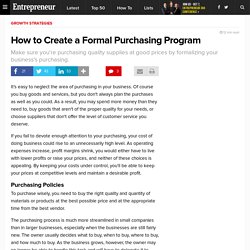
Of course you buy goods and services, but you don't always plan the purchases as well as you could. As a result, you may spend more money than they need to, buy goods that aren't of the proper quality for your needs, or choose suppliers that don't offer the level of customer service you deserve. If you fail to devote enough attention to your purchasing, your cost of doing business could rise to an unnecessarily high level. As operating expenses increase, profit margins shrink, you would either have to live with lower profits or raise your prices, and neither of these choices is appealing.
By keeping your costs under control, you'll be able to keep your prices at competitive levels and maintain a desirable profit. Purchasing Policies. Buying techniques and tips for strategic professional buyers in organizations. Competitive Retail Strategy For Fashion Merchandise New. How to Develop a responsible buying strategy Supply Business. Scalable procurement - Supply Business. How can businesses with limited procurement resources ensure that they are deployed in the most efficient and effective way?
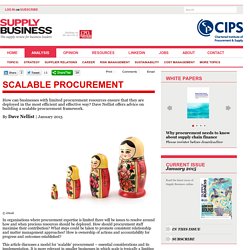
Dave Nellist offers advice on building a scalable procurement framework. By Dave Nellist | January 2015 © iStock In organisations where procurement expertise is limited there will be issues to resolve around how and when precious resources should be deployed. How should procurement staff maximise their contribution? This article discusses a model for ‘scalable’ procurement – essential considerations and its implementation. A procurement framework A scalable procurement model needs also to deliver on these goals. Free buying techniques and tips for strategic professional buyers in organizations. This webpage is a new format for mobile/small screens.
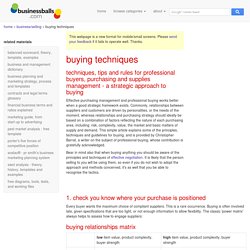
Please send your feedback if it fails to operate well. Thanks. techniques, tips and rules for professional buyers, purchasing and supplies management - a strategic approach to buying Effective purchasing management and professional buying works better when a good strategic framework exists. Commonly, relationships between suppliers and customers are driven by personalities, or the needs of the moment, whereas relationships and purchasing strategy should ideally be based on a combination of factors reflecting the nature of each purchasing area, including: risk, complexity, value, the market and basic matters of supply and demand.
Bear in mind also that when buying anything you should be aware of the principles and techniques of effective negotiation. Strategic Planning Checklist. 'retail buying strategy' on SlideShare. Seven Strategies To Beat The Retail Store Apocalypse. 5 Strategies For Profitable Retail. How to prepare your purchasing negotiation in 3 basic steps. The way to make the preparation process easy, intuitive and less monotonous is to split it in 3 clear defined steps.
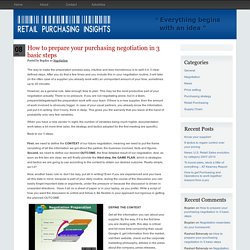
After you do that a few times and you include this in your negotiation routine, it will take (in the often case of a supplier you already work with) an unimportant amount of your time, sometimes up to 20 minutes. However, as a general rule, take enough time to plan. Assessing the value of your relationship with the supplier. Bargaining, auction or long time partnership?
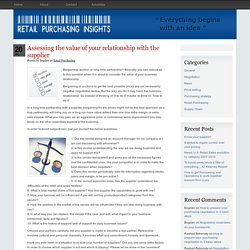
Basically you can reduce all to this question when it is about to consider the value of your business relationship. Bargaining or auctions to get the best possible prices are not necessarily negative negotiation tactics. But the way you do it may harm the business relationship. Know your supplier! Knowing your supplier is one of the best tools, weapons, instruments – no matter how you want to call it – to control the situation and always have the benefit in discussions, negotiations, day to day purchasing activity.
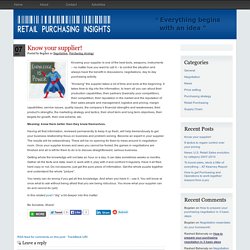
“Knowing” the supplier takes a lot of time and work at the beginning. It takes time to dig into the information, to learn all you can about their production capabilities, their partners (basically your competition), their competition; their reputation in the market and the reputation of their sales people and management; logistics and pricing, margin capabilities, service issues, quality issues, the company’s financial strengths and weaknesses, their product’s strengths, the marketing strategy and tactics, their short term and long term objectives, their targets for growth, their cost scheme, etc. Meaning: know them better than they know themselves. Getting whole the knowledge will not take an hour or a day; it can take sometimes weeks or months. Negotiation essentials: do your homework! The most important thing about preparing a negotiation is, well, doing it!
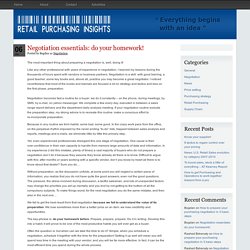
Like any other professional with years of experience in negotiation, I learned my lessons during the thousands of hours spent with vendors or business partners. Negotiation is a skill: with good training, a good teacher, some key books and, above all, practice you may become a great negotiator. I noticed nevertheless that most of the books and tutorials are focused a lot on strategy and tactics and less on the first phase, preparation. Negotiation becomes fast a routine for a buyer: we do it constantly – on the phone, during meetings, by SMS, by e-mail, on yahoo messenger. We complete a few every day, executed in between a sales range report delivery and the department daily analysis meeting. Because in any routine we form habits: some bad, some good. Yet, even experienced professionals disregard this one stage of negotiation. Retail price setting: a few considerations. Price setting is a common task for any retail buyer; it is a really massive topic to cover.

I just want to point out some key elements to take into consideration when deciding the retail price for your articles. Every category of products has its specifics. What purchasing is all about? The answer to this question is the key to my idea of doing business.
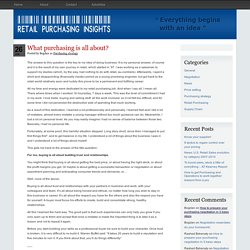
5 capital mistakes in retail purchasing. In my previous post I mentioned about Keith Cunningham’s seminar.
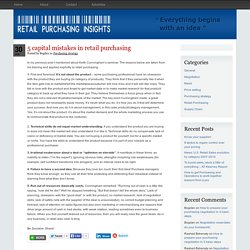
The lessons below are taken from his training and applied explicitly to retail purchasing. 1. First and foremost: it’s not about the product – some purchasing professional have an obsession with the product they are buying (or category of products). They think that if they personally like it when the item gets into to market/shelf the marketplace/costumer will love it too and it will sell like crazy. They fall in love with the product and forget to get market data or to make market research for that product/ category to back up what they have in their gut. 2. 3. 4. 5. 8 Proven Strategies For Retail Success. I had been hired in my business consultant role by a guy looking to open a new store.
What’s The Ideal Purchasing Strategy For Your Retail Supply Chain? Centralized purchasing offers a lot of efficiencies for retailers, but it’s not always the right answer to optimize your retail supply chain. Think about it: Central buyers play a huge role in determining the ideal product mix for a retail store. Usually from the retail head office, the central purchaser places inventory orders meant for all of the retailers’ local stores. These buyers work closely with vendors and suppliers to get the best price. Central buyers make the retail supply chain more cost-efficient by getting a volume discount on bulk inventory orders. Central buyers strive to stay in touch with customer demand by keeping their pulse on product trends.
International Retailing Buying Strategy. International Retailing is a procurement intensive industry. Being dependent upon Suppliers entirely for the merchandise, it becomes imperative the Companies to form a strong Supplier Strategy for Buying. Prior to 1990s, the supplies were controlled by the Suppliers. Most often, faced with limited capacity for production, the supplies would be affected as per the Supplier’s convenience and the Retailers had to wait and accept the consignments whenever they received.
The five principles of retail. If you are running a retail business — whether bricks and mortar or online — there are five core principles you need to adhere to. From customer care to the four Ps, Antony Welfare, author of The Retail Inspector’s Handbook, explains what you need to know 1 The customer is the most important person in your business The customer holds the key to every successful retail operation. Retail Merchandising Strategy Checklist. Buying & Merchandising Strategy. Home - Supply Business.